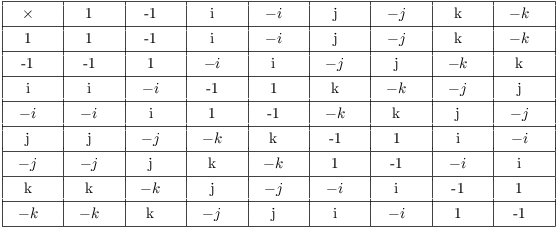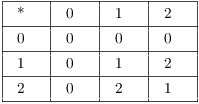Definition. A ring is
an abelian group R with binary operation + ("addition"),
together with a second binary operation ![]() ("multiplication"). The operations satisfy the following
axioms:
("multiplication"). The operations satisfy the following
axioms:
1. Multiplication is associative: For all ![]() ,
,
![]()
2. The Distributive Law holds: For all ![]() ,
,
![]()
Remark. 1. To say that R is an abelian group under addition means that the following axioms hold:
(a) (Associativity) ![]() for all
for all ![]() .
.
(b) (Identity) There is an element ![]() such that
such that ![]() and
and ![]() for all
for all ![]() .
.
(c) (Inverses) For all ![]() , there is an element
, there is an element ![]() such that
such that ![]() and
and ![]() .
.
(d) (Commutativity) ![]() for all
for all ![]() .
.
Definition. A ring R has a
multiplicative identity if there is an element ![]() such that
such that ![]() , and such that for all
, and such that for all ![]() ,
,
![]()
A ring satisfying this axiom is called a ring with 1, or a ring with identity.
Note that in the term "ring with identity", the word "identity" refers to a multiplicative identity. Every ring has an additive identity ("0") by definition.
Remark. I'll often suppress the multiplication
symbol and simply write "![]() " for "
" for "![]() ". As usual,
". As usual, ![]() means
means ![]() ,
, ![]() means
means ![]() , and so on.
, and so on.
However, note that negative powers of elements are not always defined: An element in a ring might not have a multiplicative inverse. This means that you don't always have "division"; you do have "subtraction", since that's the same as adding the additive inverse.
Many elementary algebraic operations work the way you'd expect. (There will be some surprises later, however.)
Proposition. Let R be a ring.
(a) If ![]() , then
, then ![]() .
.
(b) Let ![]() , and let
, and let ![]() denote the additive inverse of r. If R is a
ring with identity, then
denote the additive inverse of r. If R is a
ring with identity, then ![]() .
.
(c) Let ![]() . Then
. Then ![]() .
.
Proof. (a) Let ![]() . Note that
. Note that
![]()
Therefore ![]() .
.![]()
(b) Suppose R is a ring with identity, and let ![]() . Then
. Then
![]()
Therefore, ![]() is the additive inverse of r, i.e.
is the additive inverse of r, i.e. ![]() .
.![]()
(c) The proof is similar to the proof of (b).![]()
Notation. If R is a ring and n is a positive
integer, ![]() is short for
is short for ![]() (n summands). Likewise,
if n is a negative integer,
(n summands). Likewise,
if n is a negative integer, ![]() is
is ![]() . (This is the
usual convention for an abelian group.)
. (This is the
usual convention for an abelian group.)
Notice that, for example, ![]() makes sense according
to this convention: It is 1 added to itself 13 times. However, you
should not write "
makes sense according
to this convention: It is 1 added to itself 13 times. However, you
should not write "![]() ", since 13 is
not an element of
", since 13 is
not an element of ![]() .
.![]()
Definition. If R is a ring and ![]() for all
for all ![]() , R is a
commutative ring.
, R is a
commutative ring.
Note that the adjective "commutative" applies to the multiplication operation; the addition operation is always commutative by definition.
Example. Which of the following sets are rings under the usual operations? Are they commutative? Do they have an identity element?
![]()
![]() is a commutative ring with identity.
is a commutative ring with identity.
![]() is a commutative ring, but it does not have an
identity.
is a commutative ring, but it does not have an
identity.
![]() is a commutative ring with identity.
is a commutative ring with identity.
![]() , the set of positive rationals, is not a ring. It
does not contain an identity for addition.
, the set of positive rationals, is not a ring. It
does not contain an identity for addition.
![]() is a commutative ring with identity.
is a commutative ring with identity.
![]() is a commutative ring with identity.
is a commutative ring with identity.![]()
The ring of quaternions.
The ring of quaternions is the set
![]()
The "H" honors William Rowan Hamilton, who discovered the quaternions in the 1840's.
You add elements in the obvious way, e.g.
![]()
Multiply elements using the following multiplication table:

(This is the multiplication table for the group of the quaternions Q;
in ![]() , 1, i, j, and k can be multiplied by real numbers as
if they were vectors. In fact, ignoring the multiplication,
, 1, i, j, and k can be multiplied by real numbers as
if they were vectors. In fact, ignoring the multiplication, ![]() is just a 4-dimensional vector space over
is just a 4-dimensional vector space over ![]() .)
.)
For example,
![]()
![]() is a noncommutative ring, since (e.g.)
is a noncommutative ring, since (e.g.) ![]() but
but ![]() . In fact, Hamilton apparently was stuck on this
point for many years. He knew that complex numbers could be used to
represent rotations in two dimensions, and he was trying to construct
an algebraic system for representing rotations in three dimensions.
The problem is that rotations in three dimensions don't commute,
whereas he expected his algebraic system to have a commutative
multiplication --- as did all the number systems known up to that
time.
. In fact, Hamilton apparently was stuck on this
point for many years. He knew that complex numbers could be used to
represent rotations in two dimensions, and he was trying to construct
an algebraic system for representing rotations in three dimensions.
The problem is that rotations in three dimensions don't commute,
whereas he expected his algebraic system to have a commutative
multiplication --- as did all the number systems known up to that
time.
Verifying the other ring axioms is routine, but very tedious! We'll
add ![]() to our collection of common number systems, along
with the integers, the rationals, the real numbers, and the complex
numbers.
to our collection of common number systems, along
with the integers, the rationals, the real numbers, and the complex
numbers.
Example. ( The integers mod n
as rings) Construct a multiplication table for ![]() . What kind of ring is it?
. What kind of ring is it?

For example, ![]() , since as integers
, since as integers ![]() , and 4
reduces to 1 mod 3.
, and 4
reduces to 1 mod 3.
With these operations, ![]() becomes a commutative ring with 1.
becomes a commutative ring with 1.
In general, ![]() is a commutative ring with 1.
is a commutative ring with 1.![]()
Example. ( A ring without an
identity) Prove that the set of even integers ![]() with the usual operations is a ring without an
identity.
with the usual operations is a ring without an
identity.
Suppose that ![]() is an identity. Then
is an identity. Then ![]() for some
for some ![]() . Since e is an identity, I must have (for instance)
. Since e is an identity, I must have (for instance)

Since there is no integer n for which this is true, ![]() cannot have an identity.
cannot have an identity.![]()
Example. ( A ring of
matrices) ![]() is the set of
is the set of ![]() matrices with
real entries. The operations are the usual matrix addition and
multiplication. The additive identity is
matrices with
real entries. The operations are the usual matrix addition and
multiplication. The additive identity is ![]() ; the multiplicative identity is
; the multiplicative identity is
![]() .
.
Show by example that ![]() is a noncommutative ring.
is a noncommutative ring.
![]()
Example. ( A ring of
functions) ![]() is the set of continuous functions
is the set of continuous functions ![]() . Operations are pointwise addition and
multiplication:
. Operations are pointwise addition and
multiplication:
![]()
Is ![]() a commututative ring? What are the additive and
multiplicative identities?
a commututative ring? What are the additive and
multiplicative identities?
![]() is a commutative ring, since by commutativity of real
number multiplication,
is a commutative ring, since by commutativity of real
number multiplication,
![]()
The constant functions 0 and 1 are the additive and multiplicative
identities, respectively.![]()
Polynomial rings.
Let R be a commutative ring. ![]() denotes the ring
of polynomials in one variable with coefficients in R. Add and
multiply polynomials as usual.
denotes the ring
of polynomials in one variable with coefficients in R. Add and
multiply polynomials as usual.
For example, ![]() consists of all polynomials with real
coefficients: things like
consists of all polynomials with real
coefficients: things like
![]()
The formal, precise way to define ![]() is to define it to be the
collection of finite ordered n-tuples
is to define it to be the
collection of finite ordered n-tuples
![]()
(That is, a polynomial is the "vector" of its coefficients.) Now you can define addition and multiplication by writing down some ugly, unenlightening formulas. The point of mentioning this is to show that we're not doing something invalid by thinking of polynomials as "formal sums in powers of x" --- you could do things in a perfectly rigorous way if you chose.
Note that polynomials are not functions in this context. For
example, let ![]() and look at
and look at ![]() . This is
not zero as a polynomial, even though
. This is
not zero as a polynomial, even though ![]() and
and ![]() ; i.e., even though it vanishes on
every element of the ring.
; i.e., even though it vanishes on
every element of the ring.![]()
Copyright 2022 by Bruce Ikenaga